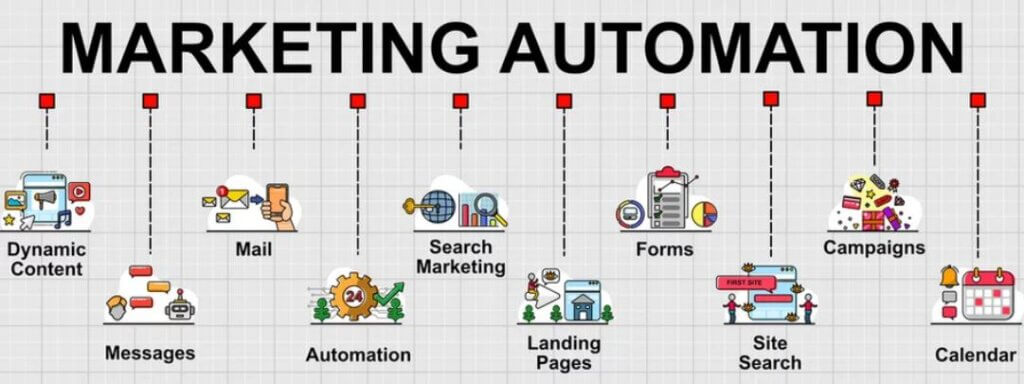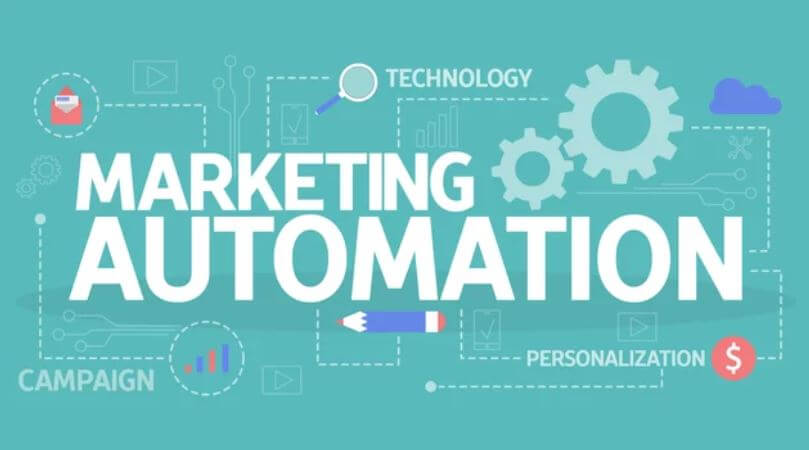Marketing Automation
Introduction of Marketing Automation
Marketing automation uses technology to streamline, automate, and measure marketing tasks and workflows to increase operational efficiency and effectiveness. It allows marketers to focus on strategy and creating personalized, relevant content, while automation handles repetitive tasks and data management.
Definition of Marketing Automation:
Marketing automation uses software and technology to automate repetitive marketing tasks, such as email campaigns, social media posts, and ad campaigns. It helps to streamline marketing efforts and improve efficiency, allowing marketers to focus on creating personalized, targeted content.
The benefit of Marketing Automation:
- Increased efficiency and productivity
- Improved customer engagement and relationships
- More effective lead generation and management
- Better data management and analysis
- Increased R.O.I. and revenue growth
Automation in marketing is a powerful tool that can help businesses of all sizes to streamline their marketing efforts and improve their results. By automating repetitive tasks and focusing on strategy and personalization, marketers can create more effective campaigns and build stronger customer relationships.
Marketing Automation Platforms
Marketing automation platforms are software tools that allow businesses to automate and streamline their marketing efforts. These platforms offer various features and functionalities, including email marketing, social media management, lead generation and management, and analytics and reporting.
Types of Platforms
- All-in-one marketing automation platforms: These platforms offer a wide range of features, including email marketing, social media management, lead generation and management, and analytics and reporting. They are suitable for businesses of all sizes.
- Email marketing platforms: These platforms focus on email marketing automation and often include features such as email design and personalization, automation, and reporting.
- Social media management platforms focus on location and include features such as scheduling posts, tracking engagement, and analyzing social media performance.
- Lead generation and management platforms: These platforms focus on lead generation and management, often including lead scoring, segmentation, and nurturing features.
Popular Platforms:
- HubSpot
- Marketo
- Pardot
- Infusionsoft
- ActiveCampaign
- Mailchimp
- Hootsuite
Choosing the Right Platform:
- Determine your specific needs and goals: Before choosing a marketing automation platform, you must understand your particular needs and goals. Consider what features and functionalities you need and what your budget is.
- Research and compare different platforms: Once you clearly understand your needs, analysis and compare other marketing automation platforms to find the one that best fits your needs.
- Test the platform: Before committing to a platform, it’s essential to ensure that it meets your needs and is user-friendly.
Marketing automation platforms offer businesses a wide range of features and functionalities to automate and streamline their marketing efforts. It’s essential to determine your specific needs and goals, research and compare different platforms, and test them before committing. Businesses can improve efficiency and effectiveness by choosing the right venue and driving revenue growth.
Lead Generation and Management
Lead generation and management is a crucial aspect of marketing automation, as it helps businesses to identify and target potential customers and then nurture those leads to convert them into paying customers.
Lead Generation Strategies:
- Content Marketing: Creating valuable content that attracts potential customers and encourages them to provide their contact information in exchange for the content.
- SEO: Optimizing your website to rank higher in search engine results can drive more traffic and increase the chances of generating leads.
- P.P.C. Advertising: Running paid advertising campaigns to drive targeted traffic to your website and increase the chances of generating leads.
- Social Media: Utilizing social media platforms to engage with potential customers and encourage them to provide their contact information.
- Trade shows and events: Participating in trade shows and events to network with potential customers and collect leads.
Lead Scoring and Segmentation:
- Lead scoring: Assigning a score to each piece of information based on how likely they are to convert into customers. This helps businesses to prioritize their efforts and focus on the most promising leads.
- Lead segmentation: Grouping leads based on specific criteria, such as demographics, interests, or behavior. This allows businesses to create more targeted and personalized campaigns.
Lead Nurturing and Drip Campaigns:
- Lead nurturing: Building relationships with potential customers by providing valuable content and offers relevant to their interests and needs.
- Drip campaigns: Automated email campaigns triggered by specific actions or behaviors. Drip campaigns allow businesses to nurture leads by providing relevant and personalized content over time.
Lead generation and management are crucial aspects of marketing automation. By implementing effective lead generation strategies, scoring and segmenting leads, and nurturing them through drip campaigns, businesses can increase their chances of converting leads into paying customers.
Email Marketing
Email marketing is one of the most widely used marketing automation techniques, as it allows businesses to communicate directly with their customers and prospects in a personalized and targeted way.
Email Campaign Types:
- Newsletters: Regularly scheduled emails that update company news, promotions, and upcoming events.
- Promotions and discounts: Emails that offer special promotions or discounts to customers and prospects.
- Abandoned cart emails are emails triggered when customers add items to their online shopping cart but fail to complete the purchase.
- Welcome emails: Emails sent to new subscribers welcome them to a company’s email list and provide information on what to expect in future emails.
- Re-engagement emails are emails sent to inactive subscribers to encourage them to re-engage with a company’s email campaigns.
Personalization and Automation:
- Personalization: Personalizing emails with the recipient’s name, location, or previous purchases can increase engagement and conversion rates.
- Automation: Setting up automated email campaigns, such as welcome emails or abandoned cart emails, can save time and ensure that the right message is sent to the right person at the right time.
Email Marketing Metrics and Analysis:
- Open rate: The percentage of recipients who opened an email.
- Click-through rate (C.T.R.): The percentage of recipients who clicked on a link within an email.
- Bounce rate: The percentage of emails that were undelivered and returned to the sender.
- Conversion rate: The percentage of recipients who completed a desired action, such as making a purchase or signing up for a free trial.
Email marketing is a powerful marketing automation technology that allows businesses to communicate directly with their customers and prospects in a personalized and targeted way. By segmenting email lists, personalizing emails, and implementing automation, companies can improve their email marketing metrics and increase their conversion rates. Additionally, businesses can make data-driven decisions to optimize their email marketing campaigns by analyzing these metrics.
Social Media Automation
Social media automation uses technology to schedule, publish, manage social media posts, and track and analyze social media metrics. It saves businesses time and resources while ensuring a consistent presence on social media.
Social Media Platforms:
- TikTok
- YouTube
Social Media Marketing Strategies:
- Content creation: Developing engaging and valuable content that aligns with your target audience’s interests, goals, and needs.
- Content curation: Sharing third-party content that complements your own and is relevant to your target audience.
- Influencer marketing: Collaborating with influencers to expand your reach and credibility.
- Paid advertising: Running paid social media campaigns to reach a larger audience or target specific demographics or behaviors.
Social Media Automation Tools:
- Hootsuite
- Buffer
- Sprout Social
- Agorapulse
- CoSchedule
- Later
- Social Pilot
Social media automation saves businesses time and resources by scheduling and publishing posts in advance, tracking and analyzing social media metrics, and ensuring a consistent presence. Businesses can reach a larger audience and increase engagement by utilizing various social media platforms, implementing multiple marketing strategies, and using automation tools. Additionally, companies can make data-driven decisions to optimize their social media efforts by analyzing metrics.
Analytics and Reporting
Analytics and reporting are critical components of marketing automation, as they allow businesses to track and measure the success of their campaigns and make data-driven decisions to optimize their efforts.
Tracking and Measuring Success:
- Identifying key performance indicators (KPIs) that align with business goals and objectives
- Setting up tracking and monitoring systems to measure the performance of campaigns
- Utilizing analytics tools to collect and analyze data
- Interpreting data and identifying patterns and trends
Analyzing Campaign Performance:
- Identifying which campaigns are performing well and which ones need improvement
- Understanding which channels, tactics, and messages are driving results
- Studying customer behavior and engagement
- Identifying opportunities for optimization
Utilizing Reporting for Optimization:
- Regularly reporting on performance and progress
- Using data to inform decision-making and strategy
- Testing and experimenting with different tactics and messages
- Continuously monitoring and adjusting campaigns for improved results
Analytics and reporting are critical components of marketing automation, allowing businesses to track and measure the success of their campaigns and make data-driven decisions to optimize their efforts. By setting up monitoring systems, utilizing analytics tools, and regularly reporting on performance, businesses can gain valuable insights into the performance of their campaigns, identify areas for improvement, and make data-driven decisions to optimize their marketing efforts and achieve their goals.
Conclusion
Marketing automation is a powerful tool that can help businesses of all sizes to streamline their marketing efforts and improve their results. Companies can improve efficiency by automating repetitive tasks and creating targeted content.
Summary of Key Points:
- Marketing automation is the use of software and technology to automate repetitive marketing tasks
- Marketing automation platforms offer various features and functionalities, including email marketing, social media management, lead generation and management, and analytics and reporting.
- Lead generation and management are crucial aspects of marketing automation. By implementing effective lead generation strategies, scoring and segmenting leads, and nurturing them through drip campaigns, businesses can increase their chances of converting leads into paying customers.
- Email marketing is a widely used marketing automation technology that allows businesses to communicate directly with their customers and prospects in a personalized and targeted way.
- Social media automation saves businesses time and resources by scheduling and publishing posts, tracking and analyzing social media metrics, and ensuring a consistent presence.
- Analytics and reporting are critical components of marketing automation, allowing businesses to track and measure the success of their campaigns and make data-driven decisions to optimize their efforts.
Future of Marketing Automation: Marketing Automation is a rapidly evolving field, and it is expected to continue to grow. Advancements in A.I. and machine learning are expected to improve the capabilities of marketing automation platforms further, allowing for even more personalized and targeted campaigns and more efficient processes.
Additional Resources for Learning:
- Hubspot’s marketing automation software blog
- Marketo’s blog
- Bardot’s blog
- Infusion soft’s blog
- ActiveCampaign’s blog
- Mailchimp’s blog
- Hootsuite’s blog
Marketing automation is a powerful tool that can help businesses improve efficiency and effectiveness, ultimately driving revenue growth. Companies can achieve their goals by understanding the different features and functionalities of marketing automation platforms, implementing effective lead generation and management strategies, utilizing email and social media marketing, and utilizing analytics and reporting. Additionally, the future of marketing automation is expected to bring even more advanced capabilities, and many resources are available to learn more about it.
F.A.Q.
What is Marketing Automation Software?
Marketing automation software is a tool that helps businesses automate repetitive tasks associated with marketing campaigns, such as email marketing, social media posting, and ad targeting. The software typically includes features such as lead generation, lead scoring, and lead nurturing, as well as the ability to track and analyze the performance of marketing campaigns.
Marketing automation software can help businesses save time and resources by automating repetitive tasks and allowing marketers to focus on strategy and analysis. Some popular features of marketing automation software include:
- Email marketing: The ability to create and send targeted email campaigns, track open and click-through rates, and segment email lists.
- Lead generation: Tools for capturing information from various sources, such as website forms and social media.
- Lead scoring: The ability to assign scores to charges based on their behavior and engagement, to help prioritize follow-up efforts.
- Lead nurturing: Automated email campaigns triggered by specific actions or behaviors, such as visiting a pricing page or downloading a whitepaper.
- Analytics and reporting: The ability to track and analyze the performance of marketing campaigns, including revenue generated and return on investment (R.O.I.).
Some examples of marketing automation software are Marketo, Hubspot, Pardot, Eloqua, and Infusionsoft.
What can I do with marketing automation?
Marketing automation software can help businesses automate and streamline various marketing tasks and activities. Some of the things you can do with marketing automation include:
- Email marketing: Create and send targeted email campaigns, track open and click-through rates, and segment email lists.
- Lead generation: Capture leads from various sources, such as website forms and social media, and automatically add them to your email lists.
- Lead scoring: Assign scores to information based on their behavior and engagement to help prioritize follow-up efforts.
- Lead nurturing: Create automated email campaigns triggered by specific actions or behaviors, such as visiting a pricing page or downloading a whitepaper.
- Customer segmentation: Use data from email campaigns, website behavior, and other sources to segment your customer base into different groups for targeted marketing campaigns.
- Personalization: Create personalized content, offers, and messages for different segments of your customer base.
- Marketing analytics: Track and analyze the performance of marketing campaigns, including revenue generated and return on investment (R.O.I.).
- Social media automation: Schedule posts, track mentions, and hashtags, and respond to customer inquiries across multiple social media platforms.
- Ad targeting: Use customer behavior and demographics data to target ads to specific customer base segments.
- Workflow automation: Create automated workflows for everyday marketing tasks, such as sending follow-up emails to leads who have not yet converted or sending targeted offers to customers who have recently purchased.
These are just a few examples of what you can do with marketing automation software. Different marketing automation tools’ range of features and capabilities can vary widely. Hence, it’s essential to research and compares other options to find the one that best meets the needs of your business.







